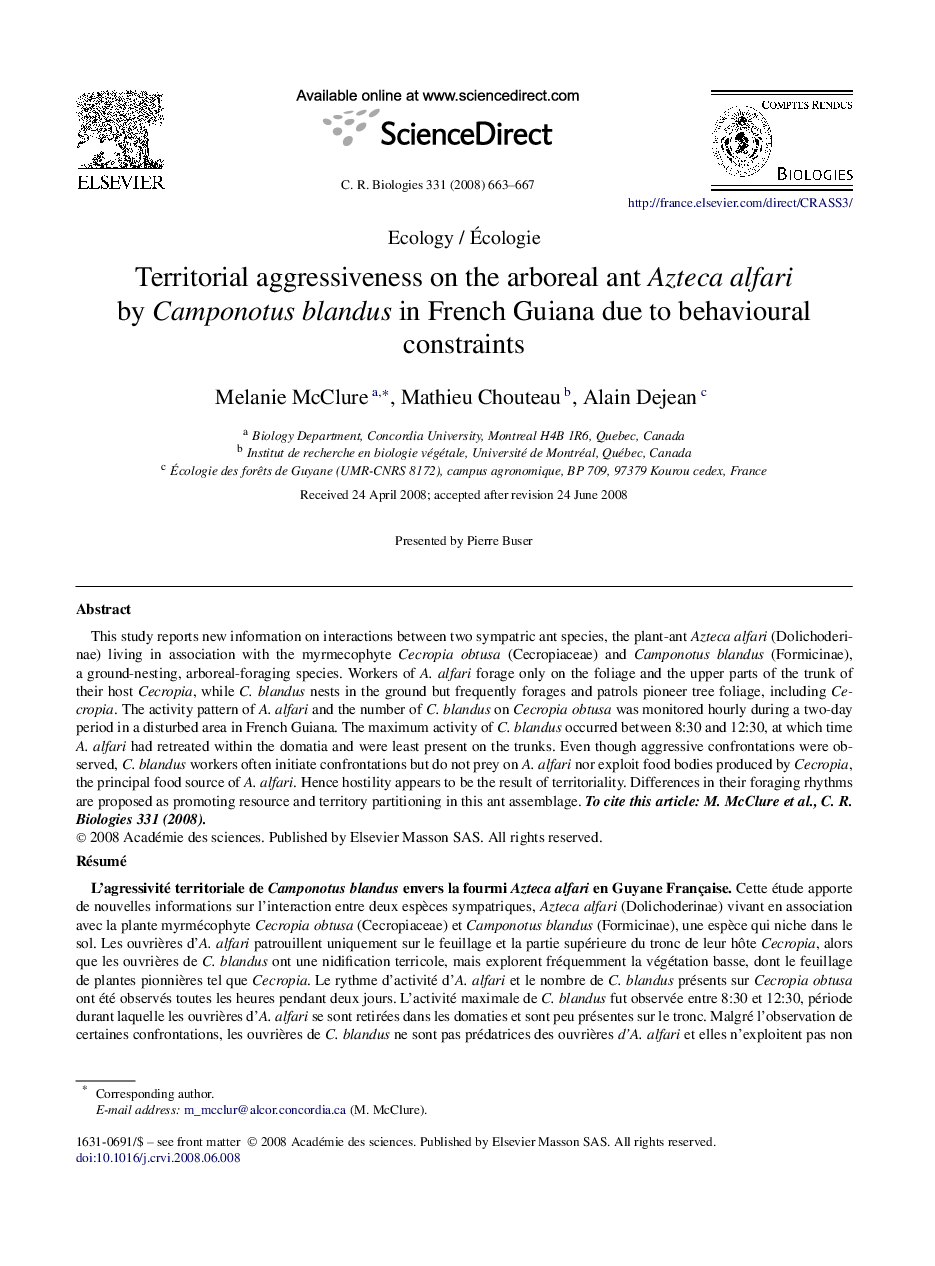| کد مقاله | کد نشریه | سال انتشار | مقاله انگلیسی | نسخه تمام متن |
|---|---|---|---|---|
| 2783937 | 1153783 | 2008 | 5 صفحه PDF | دانلود رایگان |

This study reports new information on interactions between two sympatric ant species, the plant-ant Azteca alfari (Dolichoderinae) living in association with the myrmecophyte Cecropia obtusa (Cecropiaceae) and Camponotus blandus (Formicinae), a ground-nesting, arboreal-foraging species. Workers of A. alfari forage only on the foliage and the upper parts of the trunk of their host Cecropia, while C. blandus nests in the ground but frequently forages and patrols pioneer tree foliage, including Cecropia. The activity pattern of A. alfari and the number of C. blandus on Cecropia obtusa was monitored hourly during a two-day period in a disturbed area in French Guiana. The maximum activity of C. blandus occurred between 8:30 and 12:30, at which time A. alfari had retreated within the domatia and were least present on the trunks. Even though aggressive confrontations were observed, C. blandus workers often initiate confrontations but do not prey on A. alfari nor exploit food bodies produced by Cecropia, the principal food source of A. alfari. Hence hostility appears to be the result of territoriality. Differences in their foraging rhythms are proposed as promoting resource and territory partitioning in this ant assemblage. To cite this article: M. McClure et al., C. R. Biologies 331 (2008).
RésuméCette étude apporte de nouvelles informations sur l'interaction entre deux espèces sympatriques, Azteca alfari (Dolichoderinae) vivant en association avec la plante myrmécophyte Cecropia obtusa (Cecropiaceae) et Camponotus blandus (Formicinae), une espèce qui niche dans le sol. Les ouvrières d'A. alfari patrouillent uniquement sur le feuillage et la partie supérieure du tronc de leur hôte Cecropia, alors que les ouvrières de C. blandus ont une nidification terricole, mais explorent fréquemment la végétation basse, dont le feuillage de plantes pionnières tel que Cecropia. Le rythme d'activité d'A. alfari et le nombre de C. blandus présents sur Cecropia obtusa ont été observés toutes les heures pendant deux jours. L'activité maximale de C. blandus fut observée entre 8:30 et 12:30, période durant laquelle les ouvrières d'A. alfari se sont retirées dans les domaties et sont peu présentes sur le tronc. Malgré l'observation de certaines confrontations, les ouvrières de C. blandus ne sont pas prédatrices des ouvrières d'A. alfari et elles n'exploitent pas non plus les corps nourriciers produits par les Cecropia, source principale de nourriture pour A. alfari. Ainsi l'hostilité de C. blandus semble être une conséquence de leur territorialité. Les différences au niveau des rythmes d'activité semblent promouvoir la partition des ressources dans cet assemblage de fourmis. Pour citer cet article : M. McClure et al., C. R. Biologies 331 (2008).
Journal: Comptes Rendus Biologies - Volume 331, Issue 9, September 2008, Pages 663–667